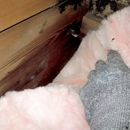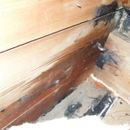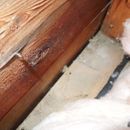Damp between insulation and exterior wall
I’ve been trying to upgrade the insulation in our 1950’s family home in Southern-Ontario and have been following some of the advice I found on this site. I have air sealed as many leaks as I could around ceiling fixtures, interior wall top plates, and the gap between the ceiling drywall the top plate of the exterior wall. I used acoustic sealant and expanding foam where applicable. I have also added some new fiberglass batts and made sure to fit them over the top plate, around studs, etc.
Today I noticed some dampness and even some frost between the exterior wall boards and the new insulation. As you can see in the attached pictures there is still a big gap between the exterior wall and the top plate, as well as the attic studs.
Do I need to go back and seal this gap as well? I don’t think I saw any recommendations on this site or others about sealing this area. Is it enough to do the top plate gap, or do I need to go up the rafters as well?
Thanks very much for any advice.
GBA Detail Library
A collection of one thousand construction details organized by climate and house part













Replies
Is this up in the attic, at a gable end, with rafters resting on the right side of those pictures? Is that an exerior corner, right at the damp spot?
It looks like you may have wall leakage convecting up that can be blocked if you seal the top plate to the wall planking in that sizeable gap seen in the last picture. Finding & fixing where he air leaks into that stud bay from the interior would be a priority too, but you can slow it down or even stop it at the top with some can-foam.
Thanks for the quick response. Yes it is the attic along the gable end and those are rafters on the right side of the last two pictures. The first two pictures are the south-east corner where we've had problems with problems with ice dams. The dampness seems to start in that corner and I posted a separate question about that area yesterday: https://www.greenbuildingadvisor.com/community/forum/general-questions/99490/adding-soffit-venting-retrofit-overhang
I've pulled the insulation back to let things dry out and will hit that large gap with expanding foam when it dries. I will seal the top plate to the wall planking along the whole gable end. I will also investigate further to see if I can find where the air leaks into that stud bay from the kitchen below.
Thanks again.
Expanding foam works well when things are slightly damp, as the moisture helps it cure better and faster. You don't want to use it when there's liquid water on the surface but there's no need to wait for it to be bone dry.
Andrew,
You can't really go wrong sealing cracks near insulation in your attic -- as long as you don't seal the ventilation gap between the top of the insulation and the roof sheathing.
When you see moisture on a cold surface, you know that there is a path that allows warm, moist interior air to reach that cold surface. Use common sense and detective work to figure out the path -- and seal those cracks.
Charlie, it's good know expanding foam can be applied to damp surfaces. Thanks for the tip.
Martin, thanks for the advice. This corner has lots of problems and there was quite a bit of frost in there this morning (see attached pic). Hopefully that will go away once I get the gaps sealed and the insulation back in place. There are small cracks to large gaps in the attic and no ventilation in this corner (see my other post link above), but I didn't see any obvious openings into the stud bay from the kitchen below. There are floor to ceiling cabinets directly beneath this corner. The interior of the cabinets are all closed in, but I don't know what's going on behind the cabinets and I'm not about to start tearing the kitchen apart right now.
Thanks again.
"When you see moisture on a cold surface, you know that there is a path that allows warm, moist interior air to reach that cold surface. Use common sense and detective work to figure out the path -- and seal those cracks."
I'm trying to use common sense to figure this stuff out, but sometimes it baffles me (pun intended). I sealed the gaps mentioned above and those problem areas seem much better now. However, I started fitting soffit baffles over the weekend, and today I noticed frost behind all of them. The frost stops right at the top of the baffle. Some have not been air sealed around the edges with expanding foam yet, but as you can see in the attached pic, the frost is just as bad behind the one on the right that has been foamed in place and the one on the left that hasn't. I would also think they are both fitting more snuggly in the rafter bay than the store bought ones that are just stapled in place. There are four rafter bays in this area, and one soffit vent.
Is frost behind the baffle normal this time of year, or is it a sign of insufficient soffit venting, lack of insulation, air sealing, all of the above? I'm just worried I might have to go back and tear things out later, so I thought I'd check in with the experts before I go much further.
Thanks very much your advice and your patience while I work through this.
Andrew,
Either (a) the section of sheathing above the baffle is colder than the rest of the roof sheathing (which is possible but somewhat unlikely) or (b) there is a source of humid air (probably warm humid air) that feeds into the baffle area (and this might be exterior air, under some weather conditions) -- or both (a) and (b).
I have been using a snow rake to clear snow off the bottom portion of the roof in an effort to combat ice dams. That might make the bottom half of the roof colder than the top half, but I've removed snow much higher than the top of the baffles. The humidity outside is about 56% today and inside it's 29%. So maybe those two conditions are causing the frost. There are no other sources of humidity like dryer or furnace vents outside this part of the house.
I guess I'll keep an eye on it and see if the frost clears up before I go any further with the installation of the baffles. If it doesn't clear up, should I remove them?
What is the % humidity in the attic?
Do you have a high powered worklight or something that is providing radiant heat to the part of the roof that is not shielded by the baffles?
"What is the % humidity in the attic?"
I put the humidity meter in there for awhile and it went up to 33%.
"Do you have a high powered worklight or something that is providing radiant heat to the part of the roof that is not shielded by the baffles?"
There's one 40W bulb in the attic and I wear a headlamp when I'm working. The frost was clearly visible behind the baffles first thing this morning and the light had been out all night.
There is some frost in other parts of the attic, but mostly on the nails and it's not solid with a defined border like it is under the baffles.
Andrew,
If the layer of fiberglass insulation on your attic floor is thin, it's possible that the top surface of your fiberglass insulation is warm enough that this surface radiates heat that warms your roof sheathing. The foam baffle in the photo interrupts this radiant heat, so the roof sheathing above the baffle is colder than the sheathing in the rest of the attic.
Here's my new theory about what I might have done wrong. I pulled out one of the baffles and noticed the frost starts right at the edge of the exterior wall (see pics). The wall boards extend above the top plate by about an inch, so I butted the edge of the baffle up against this wall board. There's also a small gap between the top plate and the exterior wall, so maybe warm air is escaping here and is being pushed up into the rafter bay where it turns to frost.
Should I cut the exterior wall board down to the top of the top plate so I can push the baffles an inch or two past the edge of the outside wall? This is going to be a lot of work, especially if I'm going to install baffles in every rafter bay. :-(
Andrew,
You wrote, "There's also a small gap between the top plate and the exterior wall." If that's true, then the placement of the baffles isn't really the issue. The issue is that you have a small gap that should have been sealed with caulk or canned spray foam, and never was.
If your observation is correct, you should seal the gap. Then it won't matter where the baffle goes.
It's not a big gap and is just the place where the exterior wall boards meet the top plate. You can see it in the second picture just above the white insulation. I'll get back in there with some caulk or foam and see if it makes a difference.
Thanks.
Happy New Year everyone! I sealed the area where the exterior wall boards meet the top plate before Christmas, but it doesn't seem to have made a difference. There really wasn't much of a gap there and I couldn't even fit a piece of paper into it. So I don't think much heat was escaping here, but I put acoustical sealant over it (you can see it one of the attached pics) and put the baffles back in place. It got pretty warm here for a awhile so there was no frost, but the temperature dropped the other night and the frost behind the baffles came back. I've sealed every gap I could find in this area, added 8" of new insulation between the ceiling joists and put more bats on top, perpendicular to the ceiling joists. So I'm not sure what to do next.
Andrew,
I assume that there is an air channel that allow air to enter the bottom of the ventilation baffle (the ventilation gap between the baffle and the roof sheathing). Somehow, this air channel is feeding moist air into the ventilation gap.
To get a good idea of what's going on, you would probably need to remove the soffit so that you can examine this area from the exterior. It's possible that gaps in your wall sheathing are providing a route for exfiltrating indoor air to enter your soffit -- but I'm just guessing.